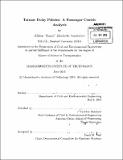Tarmac delay policies : a passenger-centric analysis
Author(s)
Vanderboll, Allison Elizabeth (Allison Sunny Elizabeth)
DownloadFull printable version (7.162Mb)
Other Contributors
Massachusetts Institute of Technology. Department of Civil and Environmental Engineering.
Advisor
Cynthia Barnhart.
Terms of use
Metadata
Show full item recordAbstract
In this work, we analyze the effectiveness of the 2010 Tarmac Delay Rule from a passenger-centric point of view. The Tarmac Delay Rule aims to protect enplaned passengers on commercial aircraft from excessively long delays upon taxi-out or taxi-in, and monetarily penalizes airlines that violate the stipulated three-hour time limit. Using an algorithm to calculate passenger delay, we quantify delays to passengers in 2007, before the Tarmac Delay Rule was enacted, and compare these delays to those estimated for hypothetical scenarios with the rule in effect for that same year. Our delay estimates are achieved using U.S. Department of Transportation data from 2007, and one quarter of booking data purchased from a large legacy carrier to validate our results. The results suggest that the rule has been a highly effective deterrent for airlines to keep tarmac times under three hours. This benefit is offset, however, because coincident with shortened tarmac delays are flight cancellations. Cancellations result in passengers requiring rebooking, and extensive delays. Through our analysis, we show that the overall impact of the Tarmac Delay Rule is a significant increase in passenger delays. We evaluate the impacts of variations to the rule, including changing the rule to apply to flights that are delayed for both less and more than the three hours stipulated in the rule, and identifying other variants of the rule that might better meet the objective of benefiting the flying public. Through extensive scenario analysis, we determine that the rule should be applied selectively, depending on flight departure times and specific network characteristics.
Description
Thesis (S.M. in Transportation)--Massachusetts Institute of Technology, Department of Civil and Environmental Engineering, 2013. Cataloged from PDF version of thesis. Includes bibliographical references (pages 73-74).
Date issued
2013Department
Massachusetts Institute of Technology. Department of Civil and Environmental EngineeringPublisher
Massachusetts Institute of Technology
Keywords
Civil and Environmental Engineering.